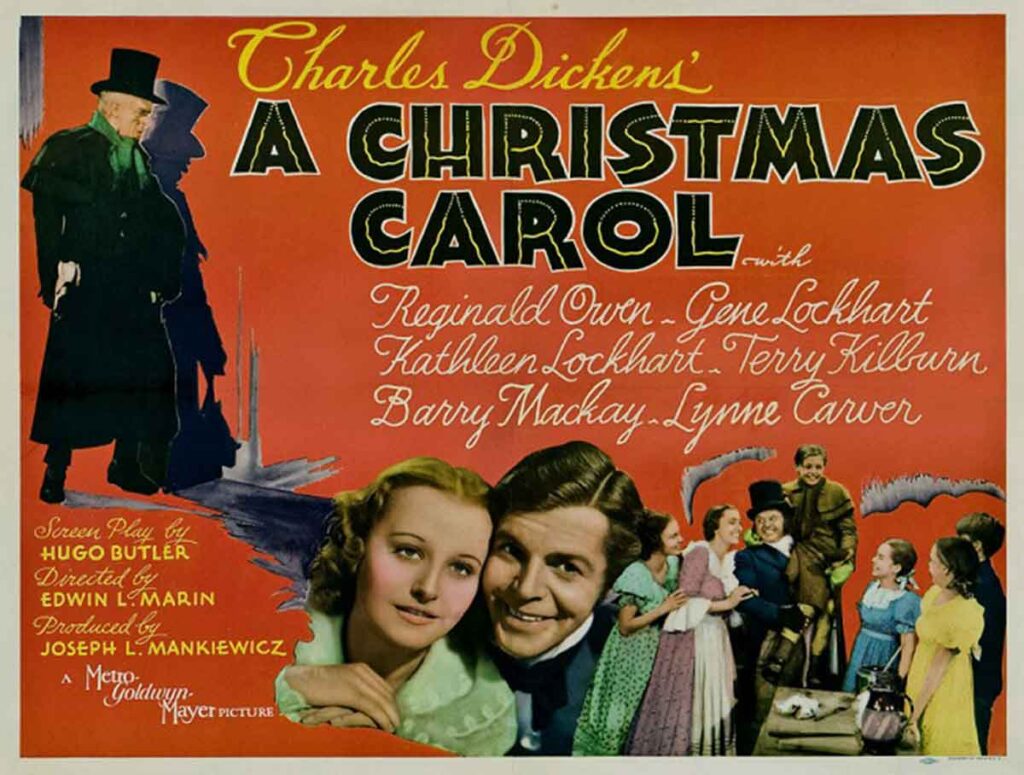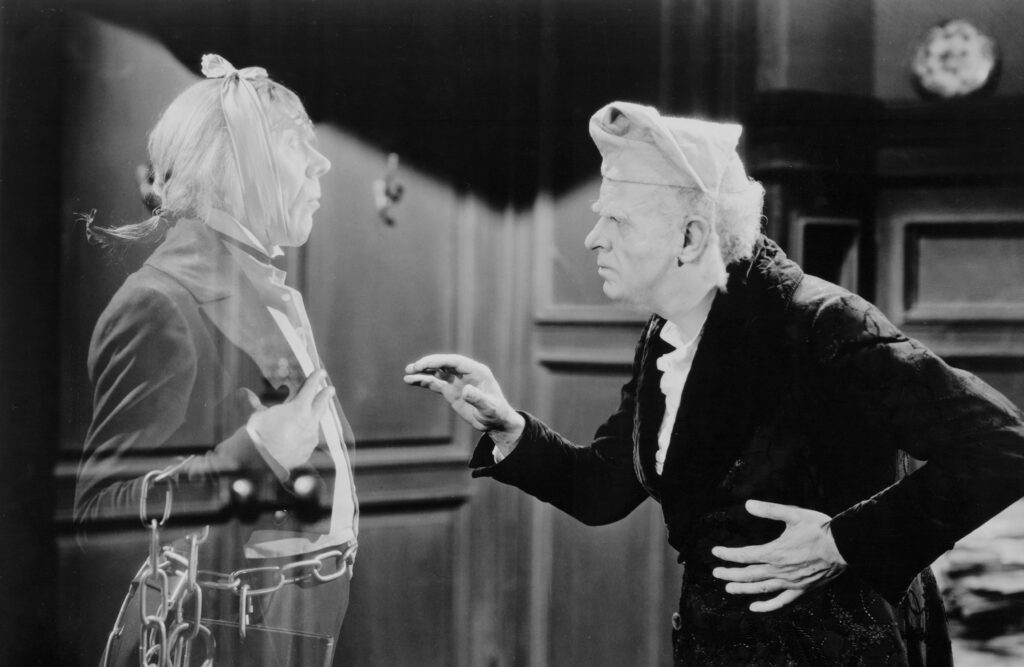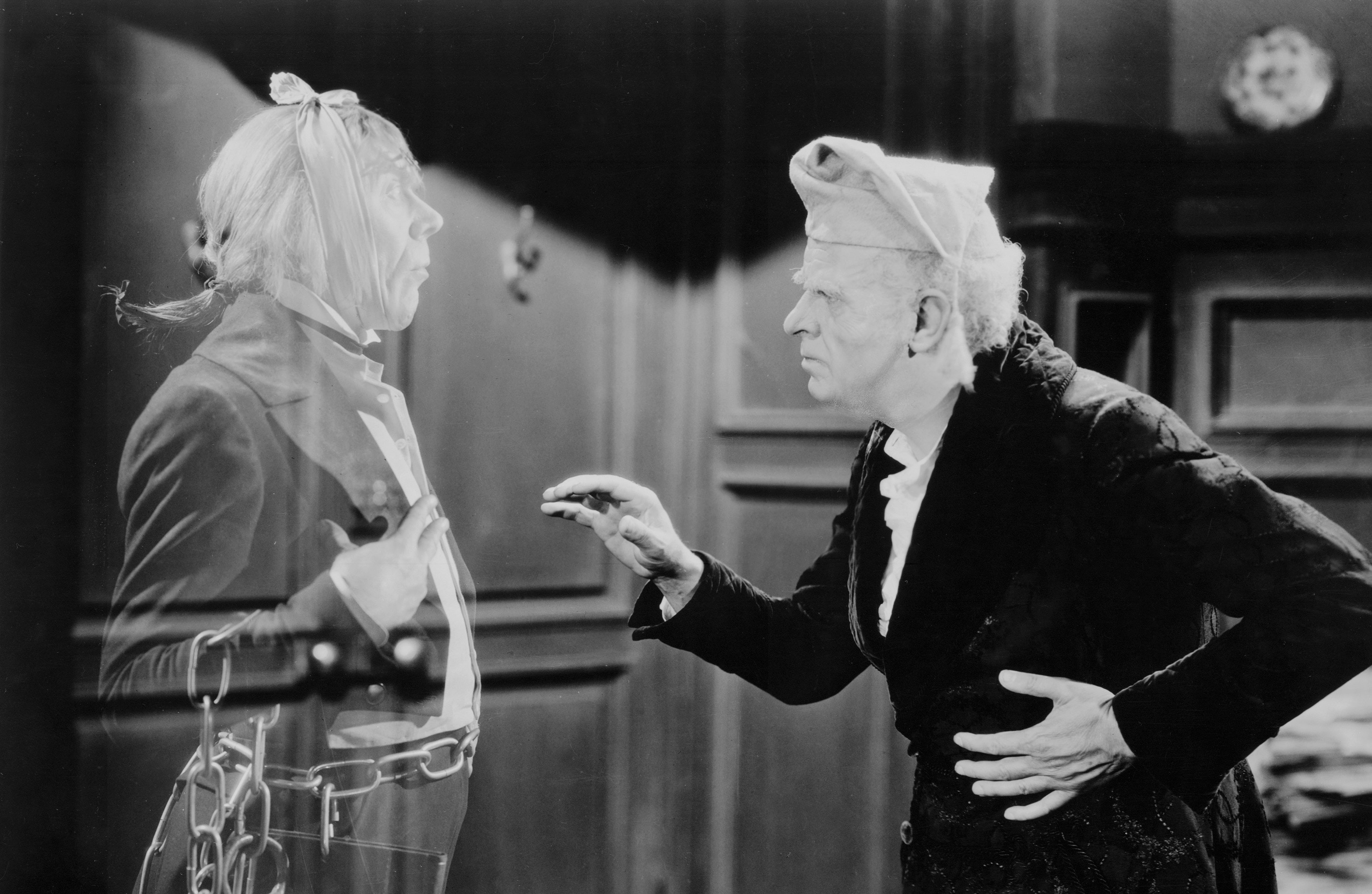A Christmas Carol 1938 is an uplifting if not very spooky version of the Dickens Yuletide classic, says guest writer HARRI TYSOE

TITLE: A Christmas Carol
YEAR RELEASE: 1938
DIRECTOR: Edwin L. Marin
CAST: Reginald Owen, Gene Lockhart, Kathleen Lockhart, Terry Kilburn, Barry MacKay
Perhaps one of the most enduring seasonal ghost stories is the tale of A Christmas Carol‘s Ebenezer Scrooge and his journey through the stages of Christmas, past, present and yet to come. In my own seasonal journey, I aim to watch some of the earliest film adaptations available to provide a perspective on how the story has evolved over the years.
MGM’s production of A Christmas Carol 1938 was initially intended to star Lionel Barrymore and some of the story was trimmed of its grimmer aspects to provide a more ‘family friendly’ film. With a star-studded cast and an impressive rendition of the historical period, the film is joyful and bright but lacks some of the spookier elements that makes this the ultimate seasonal ghost story.
The Scrooge
Reginald Owen took over the role of Ebenezer Scrooge in A Christmas Carol 1938 instead of Barrymore. A British actor who trained at the Royal Academy of Dramatic Arts, Owen had been in the US since 1920, performing on Broadway before breaking into MGM films. He is one of the few actors to have played both Sherlock Holmes and Dr Watson and was cast despite being only 51 at the time.
Despite his relative youth, Owen brings incredible skill to the performance. He oozes displeasure as he makes a bow-legged, bent-backed strut through the film, managing to look simultaneously malevolently bad tempered and also on the brink of collapsing from old age. Owen manages to drag a spider-like venomousness out of every gesture, but also brings a touch of pantomime to his character arc.
As Scrooge warms to the concept of Christmas, Owen’s performance becomes larger and more effusive which does bring a cartoonish quality to the film as he capers around his room hooting with merriment and banging his hands together. Despite this, it’s a masterful performance and one that he is quite rightfully remembered for.

The Supporting Cast
Gene Lockhart won accolades at the time for his portrayal of Bob Cratchett and it’s easy to see why. A familiar face for aficionados of classic films, Lockhart manages to bring a lot of nuance into the role.
It’s a part that straddles a careful line between humorous (as in when Cratchit is dealing with Scrooge) and thoughtful, but Lockhart quickly proves himself up to the challenge. At first he seems to be playing Cratchit as a twitchy, anxious little man but as soon as Cratchit is out from under his employer’s thumb he brings a humour and good nature to the role that exemplifies all the human goodness that this character is meant to portray.
Many other stars of the time support the cast, from Ann Rutherford as a luminescent Spirit of Christmas Past to Leo G Carroll as Marley and Forrester Harvey as Fezziwig. Not one performance hits a sour note, and it is interesting to point out that Mrs Cratchit was played by Kathleen Lockhart, Gene Lockhart’s wife. The familiarity between them creates a softness that builds well towards the gentle sadness of the Cratchit family.
The Good
Despite the production clearly being aimed at families, there is a lot left in the story that carries on The Christmas Carol theme of human goodness in adversity. One of the really impressive parts of the film were the number of historically accurate details that fleshed out the period the film was set in.
From the handkerchief binding Marley’s jaw closed in the way Victorians would often bind corpses to Bob Cratchit’s shopping montage with period appropriate ingredients and prices to a lovely scene where Scrooge and the Spirit of Christmas Present watch the poor taking their Christmas Meals to the local baker to be cooked, it made the setting visceral and believable.
Another lovely touch is the way the film tries to gently flesh out characters like Fred the Nephew and his fiance so they have more rounded real characters. The writers also make an effort to touch on things that Scrooge might miss about Christmas and social gatherings, having him beg the Spirit of Christmas Present to let him stay with parties to listen to stories or play games.
There are very clever touches to the A Christmas Carol 1938 film, including a recurring motif of an ice slide that characters dash down to demonstrate embracing the joy of Christmas over the demands of propriety and Scrooge actively firing Cratchit at the beginning which injects a sense of increased urgency into Cratchit’s position as he tries to keep it from his wife over the Christmas celebrations.
The Bad
Of course, nothing is perfect and it is very clear that this film was created with the sensibilities of the family market in mind. There are a number of cloying speeches about Christmas goodwill backed by soaring orchestral music that feel out of place in Dickens’ sharp social commentary, and an entire segment of Christmas Present takes place in a church with the ‘good’ characters singing along to hymn-like Christmas Songs.
Another jarring moment is the fast pace of Scrooge’s change of heart. Due to the relatively short run time for A Christmas Carol 1938 (a very brief 69 minutes) there wasn’t time for a truly developed character arc so some moments seem jerky and sudden. Scrooge worries about the fate of Tiny Tim before meeting the boy, and declares his heartfelt love of Christmas after viewing two small Christmas parties. Although Mr Owen does his best to pull the character off, it feels unearned by the film and therefore undermines Scrooge’s journey.
Another issue is the Spirit of Christmas Yet To Come has only a very brief appearance, the segment can’t take more than a couple of minutes and is severely cut down to confirming that yes Tiny Tim is dead and seeing a couple of Scrooge’s business associates talking about his death. There is no real menace to what should be the most menacing of all the ghosts, and even Scrooge seems barely phased by his grave as he’s already decided on his change of heart with the previous spirit.
The Spooky
This takes us to the matter of the ghosts. As a ghost story, A Christmas Carol is meant to be unnerving and the supernatural elements are dealt with in many ways throughout the adaptations; from the overtly comic in A Muppet Christmas Carol to the far darker and spookier in the 2009 animated film where Scrooge is pushed into a coffin that hangs above a literal hell by the Spirit of Christmas Yet to Come.
In this film the supernatural is given a serious air by the stellar efforts of the special effects department. Marley’s ghost is translucent and his ghostly howling is both impressive and unnerving. Scrooge even attempts to summon the police, which lends the scene a sense of believability that takes away from the dream-like effect many adaptations go for.
While the Spirits are not actively spooky, they do for the most part achieve their purpose and the scene where Scrooge is swept over London by the Spirit of Christmas Past is impressive.
Overall Festive Rating
Overall, it’s a heart-warming take on the classic, there are fine moments of humour and pathos throughout and the actors keep the story on track even when it tries to weave off into sermonising. It is not the spookiest version of A Christmas Carol but it is a very uplifting one and is well worth a watch for the festive season. 6 out of 10 spooky chains rattled.
Tell us what you think of A Christmas Carol 1938 in the comments section below!
Watch A Christmas Carol 1938 trailer
HARRI TYSOE left New Zealand to live in Scotland with their wife. They love classic films, horror and writing novels. When they aren’t working at their day job they create tiny historical costumes, draw cartoons and crochet their eternal blanket project. Check out Harri’s twitter here.




Curiously the Avenger’s Patrick Macnee has also played both Sherlock Holmes and Dr. Watson. He was Holmes in TV films The Hound of London (1993) and Sherlock Holmes: The Case of the Temporal Nexus (1996) and Watson to Roger Moore’s Holmes in Sherlock Holmes in New York (1976) and alongside Christopher Lee’s Holmes in Sherlock Holmes and the Leading Lady (1991) and Incident at Victoria Falls (1992). He also played a retired spy who was convinced he was Holmes in an episode of Magnum PI. Lee aside from Holmes also played Sir Henry Baskerville in Hammer’s The Hound of teh Baskervilles (1959) and Sherlock’s brother Mycroft in Billy Wilder’s The Private Life of Sherlock Holmes (1970)
Also June Lockhart who became famous in Tv & Film herself is Gene & Kathleen’s real daughter plays one of the kids in the Movie and if you look closely you can tell it’s her if you know her from Lost in Space & Petticoat Junction.